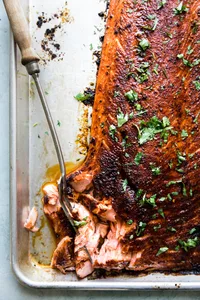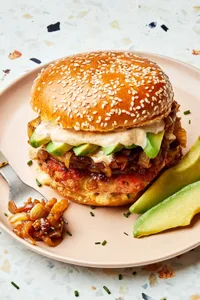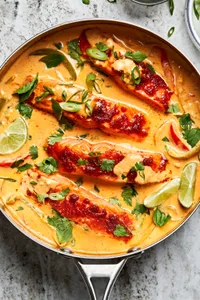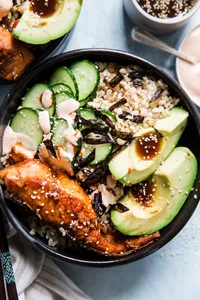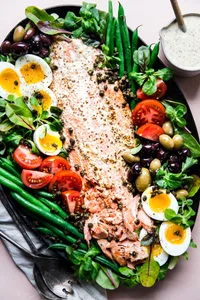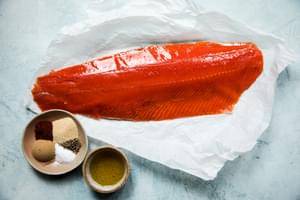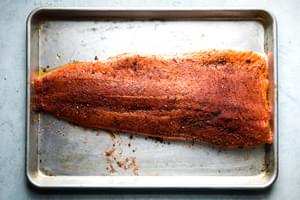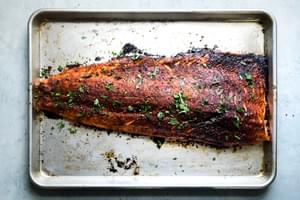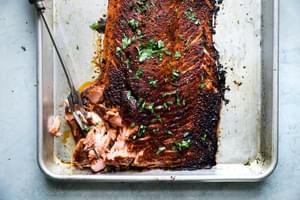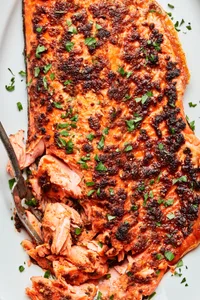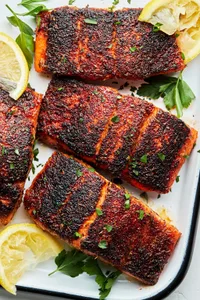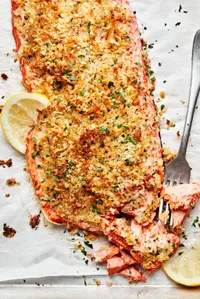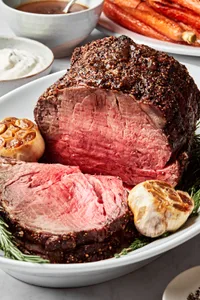Here in the Pacific Northwest, we grow up cooking and eating salmon. From a pretty young age, we were eating salmon, and by our teenage years, we were helping to prep salmon filets and helping cook the salmon! As grown ups, we realize we were pretty lucky kids. We love salmon almost any way you want to cook it — Broiled Salmon, Blackened Salmon, Miso Glazed Salmon, Parmesan Crusted Salmon, or even in Poke Bowls — but this easy baked salmon recipe is our weeknight go-to. It’s also a really great place to start if you’ve never cooked salmon before because it’s so basic. As for serving, you can dress it up with snazzy side dishes to serve to company, or enjoy it as a healthy and quick dinner on a busy weeknight! Healthy, delicious, versatile—and we promise you can master this salmon recipe in one go.
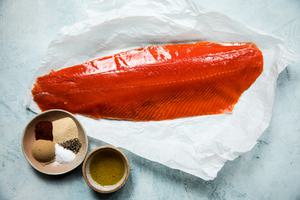
Ingredients
- Salmon. You’ll need a whole salmon filet, which just means half a salmon. It will have skin on one side and be gorgeously pink on the other. And don’t worry, the people at the fish counter will know what you mean when you ask for a two-pound filet of salmon. There are five main types of Pacific salmon, and we’ll dig into that more below in our salmon buying guide.
- Brown sugar: You’ll be amazed how just a hint of sweetness brings salmon to life. It also makes it even more kid-friendly, because it balances out the powerful salmon flavor just a bit. You can sub in honey for the brown sugar if you prefer.
- Olive oil: Just a bit of olive oil will keep the salmon beautifully moist as it bakes.
- Paprika: Not the smoked kind—just regular paprika.
- Salt & pepper: Feel free to salt to taste. Wild salmon has a rich flavor, so it doesn’t need much, but salt is always delicious — you can even go up to 2 teaspoons if you are a salt fan.
- Garlic powder: We opt for garlic powder here instead of fresh garlic because it covers the salmon filet more evenly and doesn’t interfere with the texture of the fish.
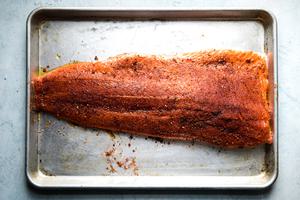
How To Bake Salmon In The Oven
- Mix the brown sugar, salt, paprika, garlic powder and black pepper.
- Line a sheet pan with foil for easy clean up and place the salmon on it skin-side down (pink side up!). Yes, you could bake the salmon directly on the pan, but just trust us, you don’t want to scrape salmon skin off an unlined baking sheet. It is the kitchen task of doom.
- Brush the salmon with olive oil — we like to use a silicone pastry brush for this job — and sprinkle it evenly with the spice mixture.
- Bake the salmon at 375°F until it’s done — this will take about 10 to 15 minutes.
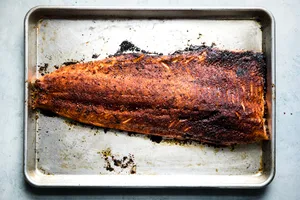
How To Tell When Salmon Is Done
- Check the salmon’s internal temperature: Checking the thickest part of the filet with an instant read thermometer, watch for the following temps: at 115°F to 125°F your salmon filet is medium-rare. At 125°F to 140°, the salmon is medium to well-done. Think of 140°F as the absolute cut off! If you see 140°F on an instant read thermometer, pull that salmon filet out of the oven! It is done! Don’t have a thermometer? Read on.
- Poke the salmon filet with a fork: We don’t really recommend this method for beginners, because it relies on a certain feel that develops over time based on a combination of sense-memory and personal preference. It can also vary a bit based on the type of salmon you buy — perfectly cooked King salmon looks different from perfectly cooked sockeye. You should be able to flake the salmon a bit with a fork, and see that the inside is cooked to your liking—very similar to how you might check a steak filet for doneness by cutting into it with a steak knife. It’s less ideal than checking with a thermometer, but if you don’t have one handy, this method will work.
- Know what level of salmon doneness you prefer: Baked salmon is a bit like steak when it comes to the perfect salmon done temp—everyone likes something a bit different. Do you like yours well-done? Rare? Medium? This may be something that takes a little trial and error before you’re sure what you like best. But once you know what perfectly cooked salmon looks like to YOU, you’ll be able to tell if salmon is done.
- Practice makes perfect: You’ll get the hang of it the more you do it. And what a delicious journey it will be!
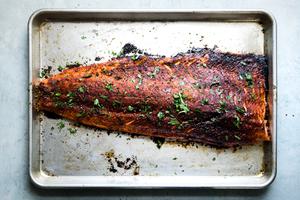
How To Buy Salmon
- Know the 5 types of salmon: Chinook (also called king salmon), sockeye, coho, pink, and chum are the five main types of salmon you’ll see. Pink salmon is usually the kind of salmon that’s canned, and chum salmon is mostly used for roe, so you’ll mostly be choosing between Chinook, sockeye and coho. Our very, very favorite is wild sockeye salmon, which tends to be lean and really meaty. We adore the sockeye salmon from Bristol Bay in Alaska, which is the largest sockeye salmon run in the world. Bristol Bay’s salmon is hand-harvested by a fleet of 8,000 fishermen in small boats, and sustainability is at the heart of their operations. They work hard to ensure the health and resiliency of fish populations and the surrounding marine ecosystem for generations to come through transparent, collaborative, careful, science-based and strict resource management, which is hugely important to us as salmon-lovers — we want to be eating salmon with our great grandkids! You can search here to find a store close to you that carries Bristol Bay Sockeye Salmon.
- Consider price: Wild salmon can cost a little more than farmed sometimes, though usually not as expensive as say, halibut. Not only are there deals to be found, salmon freezes really well, so when you do see it on sale, buy extra and freeze some for later.
- Is it better to buy fresh or frozen salmon? Basically all fish you see (whether in the freezer aisle or in the fresh fish case) was flash frozen at the time it was caught — frozen fish can be great. Flash-frozen fish can be extremely high quality — just check for additives if you’re buying frozen salmon. You want to see an ingredient list with just one thing on it: Salmon.
- Is it better to buy wild salmon or farmed salmon? Wild salmon generally tastes better than farmed, it’s our preference, and plus, it is often more sustainable (though not always). If sustainability is your primary concern, look for certifications, like those given out by the Marine Stewardship Council, or check the Monterey Bay Aquarium’s excellent “Seafood Watch” site for more detailed info about what you see in the fish case.
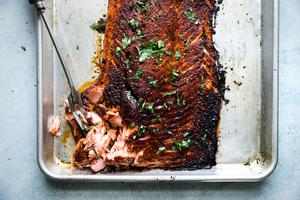
Salmon + Health
Our baked salmon recipe is about as healthy as it gets. Why? Well, you’ll find no butter here! And we use just minimal seasonings too—a pinch of salt, heart-healthy olive oil, etc. The pure, healthful goodness of salmon is unmarred and celebrated. And yes, salmon is really, really, really healthy. Salmon is a fatty fish, and fatty, in this case, is a good thing! We’re talking omega-3 fatty acids, which are polyunsaturated fats that support heart health, skin health and increasingly seem to support our bodies in other ways, too, like hormonal regulation and even may protect against some cancers. Salmon is also an excellent source of protein and vitamin A. And yes—we really do love wild Bristol Bay Sockeye Salmon. Bristol Bay’s sockeye feast on a diet of krill and plankton and that diet is responsible for the fish's vibrant red color and for its nutritional superstar status as a fabulous source of vitamins, fatty acids and the antioxidant astaxanthin, a heart-healthy, free-radical busting compound that supports whole health.
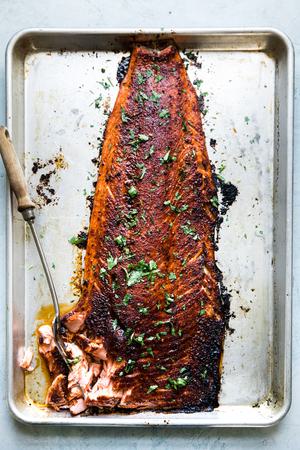
How to Store
Sadly, cooked salmon doesn’t freeze very well but leftover baked salmon will keep well in the fridge for about 3 days. We prefer to enjoy it cold — like on a salad — after it has been stored in the fridge — it doesn’t reheat very well, and the fishy flavors sometimes seem to become more pronounced when it’s been stored and reheated.
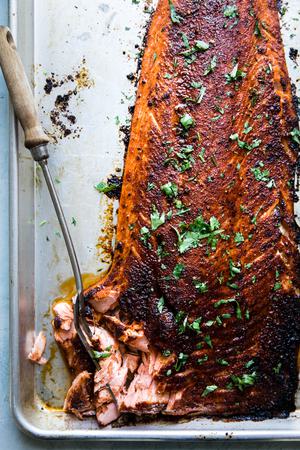
How To Use Up Leftover Salmon
- Serrano Mint Kale Salad with Salmon
- Salmon Pasta with Homemade Pesto
- Swap salmon for the ham in our classic Eggs Benedict.
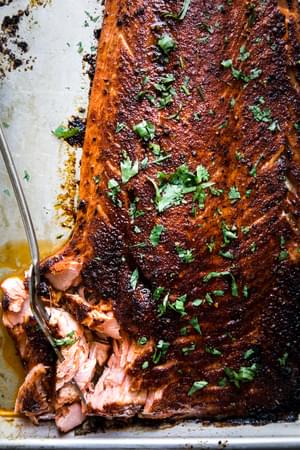
More Easy Salmon Recipes
You Did It!
For more recipe inspiration, follow us on Facebook, Instagram, TikTok and Pinterest or order our cookbook. We love when you share your meals. Tag us on Instagram using #themodernproper, and we’d love to hear what you think of this recipe in the comments below. Happy cooking!
